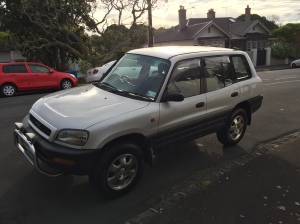As I sit in a lab in Australia waiting for my samples to make it through quarantine, maybe it’s a good time to continue my hopeless attempts to catch up on my horribly neglected blog. So, this time…CHILE!
Part of academia is going to conferences to share your research with other scientists in your field. As volcanologists, we are pretty good at making sure those conferences also often happen to be in places with awesome volcanoes. That way we can learn about local interesting geology in addition to presenting our work. I was lucky enough to attend the Cities on Volcanoes 9 conference in Puerto Varas, Chile, last November. It’s a conference all about volcanoes and the people who live near them (hence the name), hazard mitigation, communication, and more.
I was able to head to Chile a week before the conference to have a bit of a travel vacation with my workmate Mary Anne. What did I do on this vacation? Well…there’s a lot of nice scenery in Chile, and much of it includes tall pointy mountains that hot rocks come out of…and I may have spent most of my time looking at that.
But first, Santiago!
On our way to the Región de los Lagos, the part of the country where the conference was, we had a one day stop in Chile’s capital, Santiago. Enough time to take a look around, check out some nice parks and markets, and have some great food.
Onwards to volcanoes: Hornopirén
The next day Mary Anne and I flew down to Puerto Montt, the city at the northernmost end of Patagonia, and rented a car so we could drive to some of the more out-of-the-way areas to the south. We were taking the Carretera Austral, the road that goes from the end of the Pan-American Highway as far south in Chile as you can go. It’s very much still a work in progress. Much of it is unpaved, and there are several ferry crossings where the road comes to an end.
Our first stop was in Hornopirén, a small town near a national park and a few volcanoes. We did our first ferry crossing and found our way to a nice cabaña with fireplace–lucky since it spent the next day raining so hard we could barely do anything!
We were supposed to head on fairly quickly to our next location, but a ferry scheduling issue meant we had to stay an extra day. The silver lining was that it meant we had time to do the things we were rained out of the first day. We had a great hike to Lago Cabrera, the site of Chile’s biggest volcanic death toll. In the 1950s there was a rockfall from Yate volcano that fell into the lake, which caused a tidal wave destroying a settlement on the other side, killing 26 people.
Onward to…more volcanoes?: Parque Pumalín
Once we finally sorted our ferry, we headed off further south. First a 3 hour trip, a short driving break, and then another short ferry ride to get to Parque Pumalín, a privately maintained conservation area with beautiful views and–you guessed it–a few more volcanoes!
The park is home to Chaitén volcano, which had a violent and destructive 2008 eruption, severely affecting the nearby town of the same name. As we drove through the park to the town where we were staying it was easy to see the effects of that eruption.
Our host gave us some recommendations for hikes the next day. Of course we were going to climb a volcano (duh…) but we had more time than that. We used to visit some waterfalls and more alerce trees. Our first hike was the Cascadas Escondidas trail, or the “hidden waterfalls”.
But of course the start of the show was Chaitén volcano. We took a few hour hike up to the top in the afternoon and got great views of the still smoking dome.
Back to work!: return to Puerto Varas
Our pre-conference week was coming to an end, so we hopped on a 9-hour ferry back up to where we started. I got to work on my Spanish quite a bit more by watching some extremely family-inappropriate pirated movies that were being shown and had a chance to get a different view of some of the places we’ve been.
Upon getting back, we had one more day with the car, so we took a trip to the the Saltos de Petrohué, a series of rapids and waterfalls near still more volcanoes!
Another thing that was fun about the trip to this point was the language. While I studied Spanish all through high school and have practiced it beyond that, I’ve never had the chance to use it in a practical setting before. In the places we went, most people spoke no English, so I had to stretch my Spanish knowledge to its limit, and it was super fun. I felt like I was improving as the trip progressed, and really happy with how well I did.
Halfway point in the trip is a good point for a break! I promise I will finish the second half soon! You believe me, don’t you?





















































































































































































































































































